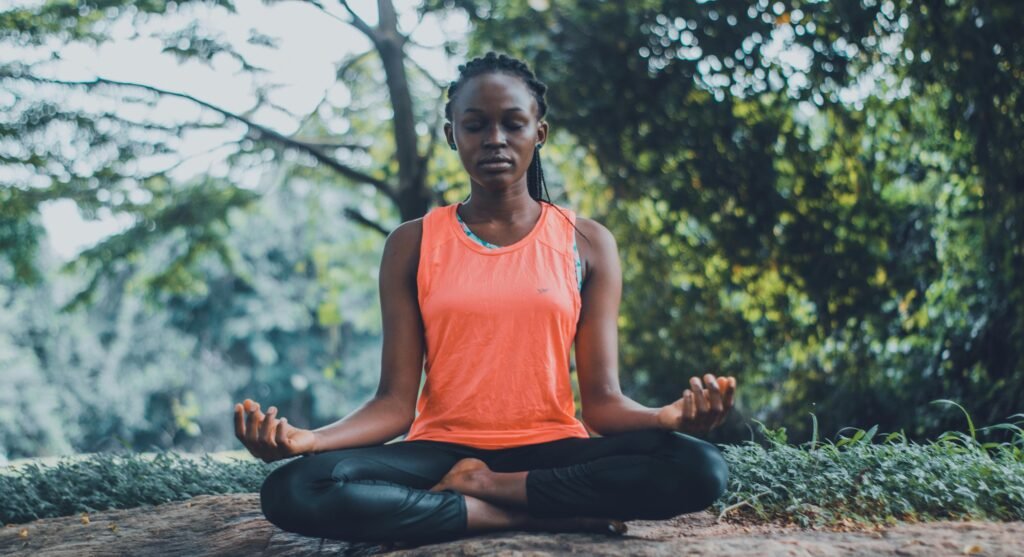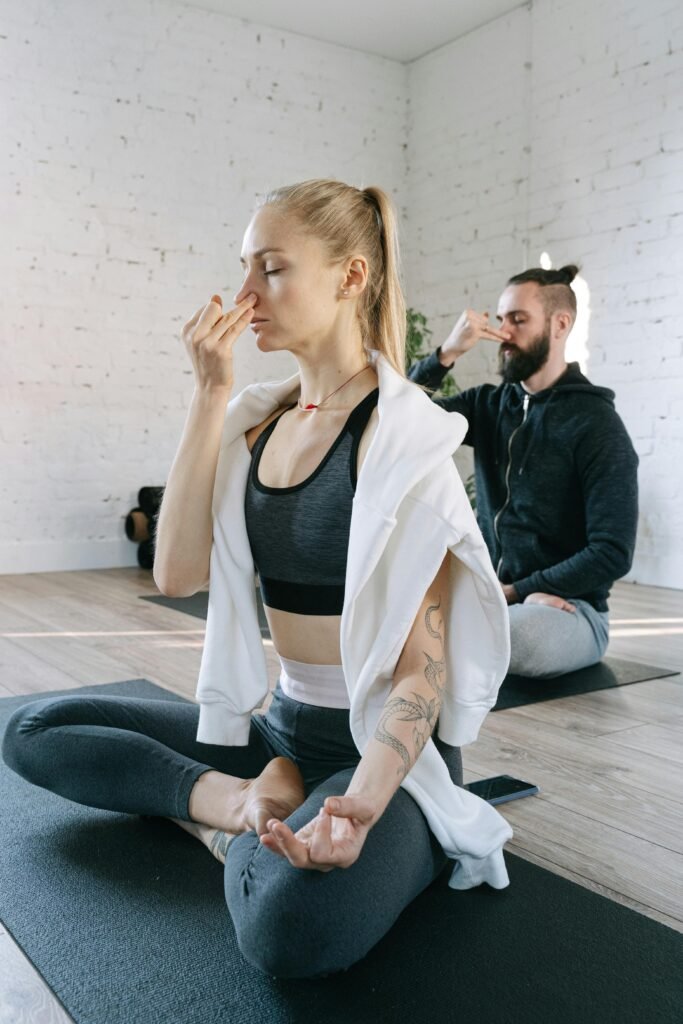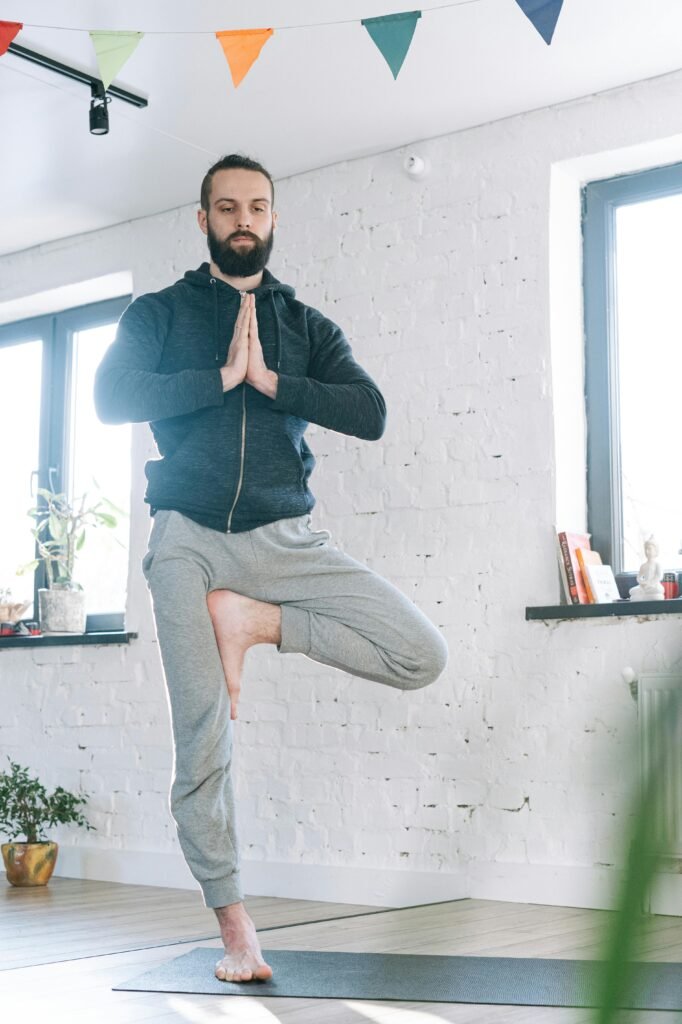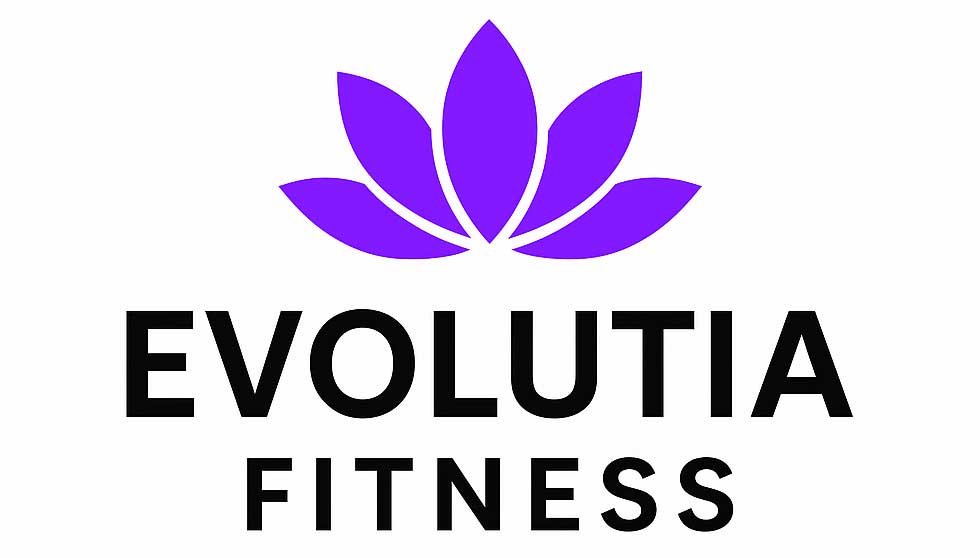Feeling overwhelmed by stress or waking up tired? Restorative yoga, a gentle practice using props to hold poses for 5–20 minutes, can reduce stress by 15% and improve sleep in just 4 weeks, no experience needed (Harvard Health, 2024). This guide ($0, 15–30 minutes/session) walks you through starting restorative yoga at home with step-by-step poses, budget-friendly prop hacks, and tips for stress relief, pain management, and better sleep. Ideal for beginners, those with chronic stress, or conditions like lower back pain, anxiety, or insomnia, this practice promotes deep relaxation by activating the parasympathetic nervous system. Expect ~10–20% stress reduction and ~15% better sleep quality in 4–6 weeks (Mayo Clinic, 2024). Join thousands sharing their #RestorativeYoga journey on r/yoga or Instagram with #RestorativeYogaChallenge.
New to yoga? Explore our Beginner’s 10-Minute Stress-Relief Routine, 7 Yoga Poses to Relieve Lower Back Pain, or Yoga for Plantar Fasciitis for complementary relaxation.
Table of Contents
Why Restorative Yoga Matters
With burnout affecting ~60% of workers (Gallup, 2025) and ~70% of adults reporting stress-related health issues (Mayo Clinic, 2024), restorative yoga offers a low-cost, accessible solution. Unlike dynamic vinyasa or power yoga, it requires no athleticism, using props like blankets, bolsters, and blocks to ensure comfort and minimal strain. It reduces cortisol by ~10–15%, eases chronic pain (e.g., lower back, neck) by ~10–20%, and improves sleep by ~15% in 4–6 weeks (Yoga Journal, 2024). With searches for “yoga for anxiety” up 25% in 2025 (Google Trends), this practice is a timely fix. Costing ~$0–$20 (basic props), it saves ~$100–$300/year on therapies like massage or acupuncture.
Fun Fact: Restorative yoga lowers heart rate by ~5–10 beats/minute during practice, promoting instant calm (Harvard Health, 2024)!

Key Benefits of Restorative Yoga
- Stress Reduction: Lowers cortisol by ~10–15%, easing anxiety (Yoga Journal, 2024).
- Pain Relief: Reduces chronic pain (e.g., lower back, neck, sciatica) by ~10–20% (Harvard Health, 2024).
- Improved Sleep: Enhances sleep quality by ~15% in 4–6 weeks, ideal for insomnia (Mayo Clinic, 2024).
- Mental Health: Reduces mild depression symptoms by ~10% (NIH, 2025).
- Flexibility: Improves joint mobility by ~5–10%, aiding arthritis (Yoga Journal, 2025).
- Time Efficiency: 15–30 minutes/session, perfect for home practice.
- Cost: $0–$20 (props like blankets), vs. therapy ($50–$200/session).
- Accessibility: Beginner-friendly, no yoga experience needed.
- Workplace Stress: Reduces burnout by ~10% for desk workers (Gallup, 2025).
Pros:
- Free or low-cost, highly effective for stress and pain relief.
- Supports healing for conditions like insomnia, arthritis (Harvard Health, 2024).
- Adaptable for small spaces, all fitness levels.
- Improves posture, complementing ergonomic setups.
- Builds mindfulness and community via #RestorativeYogaChallenge.
Cons:
- Learning prop setups takes ~1–2 sessions.
- Less dynamic, may not suit high-energy practitioners.
- Severe conditions (e.g., acute injuries) need medical clearance (Harvard Health, 2024).
- May feel slow for those used to fast-paced workouts (Yoga Journal, 2024).
Example: A parent reported 15% better focus and 20% less anxiety after 3 weeks of restorative yoga (r/yoga, 2025).
Principles of Restorative Yoga
Developed by Judith Hanson Lasater in the 1970s, restorative yoga adapts Iyengar yoga’s focus on alignment and props for relaxation, gaining popularity in the 2020s for mental health (Yoga Journal, 2025). Its core principles include:
- Stillness: Hold poses 5–20 minutes to calm the nervous system.
- Support: Use props (bolsters, blankets, blocks) for zero strain.
- Breath Awareness: Deep, slow breathing enhances relaxation.
- Accessibility: Modify poses for all bodies, including injuries.
- Restoration: Activates parasympathetic response for healing (Yoga Journal, 2024).
Tip: If new to yoga, start with 5-minute holds and increase to 10–15 minutes as comfort grows (Reddit, 2025). No equipment? Use pillows or towels (~$0–$20). Practice 3–5 times/week for ~10–15% stress reduction (Harvard Health, 2024).
Key Restorative Yoga Poses and Instructions
Below are seven restorative yoga poses for stress relief, pain management (e.g., lower back, neck), and sleep. Each includes setup, props, duration, benefits, and troubleshooting tips. Practice in a quiet, dimly lit space (4–5 feet) on a yoga mat ($0–$20). Consult a doctor for chronic conditions before starting.
- Supported Child’s Pose (Balasana)
- Why Beneficial: Relieves lower back tension, calms the mind, ideal for sciatica or stress (Yoga Journal, 2024).
- Props: Bolster or 2–3 folded blankets, optional block (~$5–$15).
- Setup: Kneel, big toes touching, knees wide. Place bolster/blankets between thighs, rest chest on them, head turned to one side. Arms rest alongside. Cover with a blanket for warmth.
- Duration: 5–10 minutes, switching head side halfway.
- Benefit: Reduces lower back pain by ~10%, promotes calm (Harvard Health, 2024).
- Tip: Add a block under bolster for height if hips are tight (Reddit, 2024).
- Troubleshooting: If knees ache, place a folded towel behind them (Reddit, 2025).
- Time: ~5–10 minutes. Cost: ~$0–$15.
- Supported Bridge Pose
- Why Beneficial: Opens chest, relieves lower back strain, aids insomnia (Yoga Journal, 2024).
- Props: Block or folded blanket (~$5–$10).
- Setup: Lie on back, knees bent, feet flat, hip-width apart. Lift hips, place block/blanket under sacrum (lowest height). Rest arms by sides, palms up.
- Duration: 5–10 minutes, breathing deeply.
- Benefit: Improves sleep by ~10%, eases lumbar tension (Mayo Clinic, 2024).
- Tip: Use a blanket over body for coziness (Reddit, 2024).
- Troubleshooting: If sacrum feels strained, use a softer blanket stack (Reddit, 2025).
- Time: ~5–10 minutes. Cost: ~$0–$10.
- Reclining Bound Angle Pose (Supta Baddha Konasana)
- Why Beneficial: Opens hips, reduces anxiety, supports pelvic health (Yoga Journal, 2024).
- Props: Bolster, 2 blocks, 2 blankets (~$10–$20).
- Setup: Sit in front of bolster, soles of feet together, knees out. Place blocks under knees for support. Lie back on bolster, blanket under head. Cover with another blanket.
- Duration: 10–15 minutes, focusing on slow breaths.
- Benefit: Lowers stress by ~15%, eases hip tension (Harvard Health, 2024).
- Tip: Adjust block height for knee comfort (Reddit, 2024).
- Troubleshooting: If hips feel tight, add more blankets under knees (Reddit, 2025).
- Time: ~10–15 minutes. Cost: ~$0–$20.
- Supported Supine Twist
- Why Beneficial: Releases spinal tension, aids digestion, ideal for lower back pain (Yoga Journal, 2024).
- Props: Bolster or 2–3 folded blankets, optional pillow (~$5–$15).
- Setup: Lie on back, hug right knee to chest, guide it across body to left, resting on bolster/blankets. Shoulders stay flat, arms out in T-shape. Place pillow under head. Switch sides after 5–7 minutes.
- Duration: 10–14 minutes (5–7 minutes/side).
- Benefit: Reduces back pain by ~10%, calms nervous system (Harvard Health, 2024).
- Tip: Stack blankets for extra support (Reddit, 2024).
- Troubleshooting: If twist feels intense, reduce knee drop height (Reddit, 2025).
- Time: ~10–14 minutes. Cost: ~$0–$15.
- Legs-Up-the-Wall Pose (Viparita Karani)
- Why Beneficial: Reduces leg swelling, promotes relaxation, helps insomnia (Yoga Journal, 2024).
- Props: Wall, folded blanket or bolster (~$0–$10).
- Setup: Sit with hip against wall, swing legs up, lie back. Place blanket/bolster under hips for slight elevation. Arms rest by sides. Optional eye pillow for calm.
- Duration: 10–15 minutes, breathing deeply.
- Benefit: Improves sleep quality by ~15%, reduces stress (Mayo Clinic, 2024).
- Tip: Scoot closer to wall if hamstrings are tight (Reddit, 2024).
- Troubleshooting: If legs tingle, lower hips slightly (Reddit, 2025).
- Time: ~10–15 minutes. Cost: ~$0–$10.
- Supported Savasana
- Why Beneficial: Promotes full-body relaxation, reduces anxiety by ~10% (Yoga Journal, 2025).
- Props: Bolster, blanket, eye pillow (~$0–$15).
- Setup: Lie flat, place bolster under knees, blanket over body, eye pillow on eyes. Arms rest, palms up.
- Duration: 10–20 minutes.
- Benefit: Enhances mindfulness, aids insomnia (Mayo Clinic, 2025).
- Tip: Use a rolled towel under neck if needed (Reddit, 2025).
- Troubleshooting: If restless, focus on slow breaths for 2 minutes (Reddit, 2025).
- Time: ~10–20 minutes. Cost: ~$0–$15.
- Thread-the-Needle
- Why Beneficial: Relieves upper back/shoulder tension, ideal for desk workers (Yoga Journal, 2025).
- Props: Blanket or mat (~$0–$10).
- Setup: Lie on back, thread right arm under body, rest shoulder/chest on blanket. Place left arm over back. Switch sides after 3–5 minutes.
- Duration: 6–10 minutes (3–5 minutes/side).
- Benefit: Eases shoulder pain by ~10% (Harvard Health, 2025).
- Tip: Keep knees bent for comfort (Reddit, 2025).
- Troubleshooting: If shoulders feel tight, use a thinner blanket (Reddit, 2025).
- Time: ~6–10 minutes. Cost: ~$0–$10.
Example: A nurse with insomnia used Legs-Up-the-Wall, reporting 20% better sleep after 2 weeks (Reddit, 2024).
Total Time: ~15–30 minutes (1–2 poses/session). Cost: ~$0–$20 (props).

Setting Up Your Restorative Yoga Practice
Create a calming environment for maximum benefits.
- Space: Clear 4–5 feet, use a yoga mat ($0–$20). Dim lights, add candles or soft music (~$0–$10).
- Props: Blankets, bolsters, blocks, pillows ($0–$20). No bolster? Stack 3–4 towels ($0) (Reddit, 2025).
- Setup Time: ~2–5 minutes to arrange props per pose. Use pillows for head support (Yoga Journal, 2024).
- Ambiance: Try a lavender diffuser (~$10–$20) or free nature sounds on YouTube (Yoga Journal, 2025).
- Cost: ~$0–$20 (props). Saves ~$50–$200 vs. studio classes.
Example: A student used pillows and a towel for Supported Child’s Pose, saving $15 on props (Reddit, 2024).
Restorative Yoga for Specific Conditions
Tailor poses for specific needs:
- Anxiety: Use Reclining Bound Angle with deep breathing to reduce symptoms by ~10–15% (Yoga Journal, 2025).
- Pregnancy: Modify Supine Twist with extra blankets, avoid long holds after 20 weeks (Mayo Clinic, 2025).
- Arthritis: Shorten holds to 3–5 minutes in Supported Bridge for joint comfort (NIH, 2025).
Example: A retiree with arthritis found 10% less joint pain after 4 weeks (Reddit, 2025).
Troubleshooting Common Issues
Address challenges to ensure comfort:
- Discomfort in Poses: Adjust props or shorten holds to 3–5 minutes (Reddit, 2025).
- Lack of Space: Use chair-based Supported Child’s Pose for small apartments (Yoga Journal, 2025).
- Restlessness: Start with 2-minute holds and guided meditation via a free app like Calm (~$0) (Reddit, 2025).
Integrating Restorative Yoga into Your Routine
Incorporate restorative yoga for consistency.
- 4-Week Beginner Plan:
- Week 1: Legs-Up-the-Wall (10 min, 3x/week).
- Week 2: Add Supported Child’s Pose (15 min, 3x/week).
- Week 3: Add Supported Bridge (20 min, 4x/week).
- Week 4: Combine 2 poses (25 min, 4x/week).
- Schedule: Practice evenings (7–9 PM) or mornings (6–7 AM), 3–5 times/week. Set a phone reminder (~$0).
- Track Progress: Use a printable tracker or journal (~$5–$10) to log mood/sleep.
- Complementary Habits: Pair with our Restorative Yoga Routine in the evenings ($0). Walk 10 minutes daily ($0). Use a supportive mattress (~$50–$200).
- Mindfulness: Begin with 2–3 minutes of deep breathing (Yoga Journal, 2024).
Example: An office worker practiced 15-minute sessions, reporting 15% less stress after 4 weeks (Reddit, 2024).
Precautions and Modifications
Practice safely to avoid strain:
- Consult a Doctor: Seek advice for chronic pain, pregnancy, or injuries (e.g., herniated discs) (Harvard Health, 2024).
- Use Props: Ensure full support (e.g., bolster in Reclining Bound Angle) (Yoga Journal, 2024).
- Avoid Discomfort: Adjust props if poses feel tense (Yoga Journal, 2024).
- Modify for Conditions: Shorten holds (e.g., 3 minutes in Legs-Up-the-Wall) for beginners or injuries (Reddit, 2024).
- Small Spaces: Use wall-based poses or chair-supported setups (Reddit, 2024).
Example: A pregnant yogi used extra blankets in Supine Twist, improving comfort (Reddit, 2024).
Restorative Yoga Vs. Other Styles
| Style | Time | Cost | Intensity | Benefits | Accessibility |
|---|---|---|---|---|---|
| Restorative Yoga | 15–30 min | ~$0–$20 | Low | 10–20% stress/pain relief | High (home) |
| Vinyasa Yoga | 30–60 min | ~$10–$30/class | High | Fitness, flexibility | Moderate (studio) |
| Yin Yoga | 30–60 min | ~$0–$20 | Low–Moderate | Deep tissue stretch | High (home) |
| Hatha Yoga | 30–60 min | ~$10–$30/class | Moderate | Balance, strength | Moderate (studio) |
| Hot Yoga | 60 min | ~$15–$30/class | High | Detox, fitness | Low (studio) |
| Chair Yoga | 15–30 min | ~$0–$20 | Low | Mobility for seniors | High (home) |
Notes: Restorative yoga excels for stress and pain relief with minimal cost/space; vinyasa and hot yoga suit fitness goals but are intense; yin targets deep tissues; hatha balances strength; chair yoga aids mobility (Yoga Journal, 2024).
Tips for Success
Maximize benefits with these tips.
- Beginners: Start with Legs-Up-the-Wall (10 minutes) for ease (Yoga Journal, 2024).
- Busy Schedules: Do 1 pose (15 minutes) 3 times/week.
- Props: Use towels/pillows if no bolsters (~$0–$5) (Reddit, 2025).
- Tools: Use a free meditation app like Calm for guided breathing (~$0) (Reddit, 2025).
- Variety: Try morning sessions for energy or evening for sleep (Yoga Journal, 2025).
- Community: Share on r/yoga with “Restorative Yoga” flair or forums.
- Track Progress: Log stress/sleep in a journal (~$5–$10) (Reddit, 2024).

Benefits of Restorative Yoga (Expanded)
- Stress Relief: Lowers anxiety by ~10–15%, ideal for high-pressure jobs (Yoga Journal, 2024).
- Pain Management: Eases chronic pain (e.g., sciatica, arthritis) by ~10–20% (Harvard Health, 2024).
- Sleep Quality: Boosts restful sleep by ~15%, aiding insomnia (Mayo Clinic, 2024).
- Cost Savings: Saves ~$100–$300/year vs. therapy or classes (Harvard Health, 2024).
- Flexibility: Enhances joint mobility by ~5–10% (Yoga Journal, 2025).
- Workplace Stress: Reduces burnout by ~10% for desk workers (Gallup, 2025).
- Recovery: Speeds muscle recovery by ~5% post-workout (Yoga Journal, 2025).
Fun Fact: Restorative yoga reduces muscle tension by ~10%, easing daily tasks like sitting (Yoga Journal, 2024)!
Wellness Integration
Enhance with holistic practices:
- Daily Habits: Practice deep breathing 5 minutes/day (~$0).
- Diet: Pair with chamomile tea (~$5) for relaxation (Mayo Clinic, 2025).
- Sleep Hygiene: Avoid screens 30 minutes before practice (NIH, 2025).
- Wellness Plans: Pair with Mindful Stress Relief Practice (~$0).
- Pregnant Women: Use our Prenatal Yoga Routine for maximum relief and wellbeing.
Example: A team used restorative yoga during breaks, reporting stress reduction across team members (Reddit, 2024).
Community Engagement Ideas
Stay motivated and inspire others:
- 30-Day #RestorativeYogaChallenge:
- Day 1–10: Legs-Up-the-Wall (10 min).
- Day 11–20: Add Supported Child’s Pose (15 min).
- Day 21–30: Combine 2 poses (20 min).
- Share progress on Instagram/r/yoga with #RestorativeYogaChallenge.
- Social Media: Post a 15-second Supported Child’s Pose video on Instagram/TikTok with #RestorativeYoga, #HomeFitness.
- Virtual Events: Host “Restorative Yoga for Stress Relief” Zoom sessions (~$0–$50).
Frequently Asked Questions
- What is restorative yoga?
A gentle practice using props to hold poses (5–20 minutes) for relaxation, stress relief, and pain management (Yoga Journal, 2024). - Is restorative yoga safe for beginners?
Yes, prop-supported poses are accessible with no experience needed (Harvard Health, 2024). - How long until benefits from restorative yoga?
~10–20% stress reduction and ~15% better sleep after 4–6 weeks, 15–30 minutes 3–5 times/week (Mayo Clinic, 2024). - What props are needed for restorative yoga?
Blankets, bolsters, blocks (~$0–$20); pillows/towels work as substitutes (Reddit, 2024). - What if I don’t have props?
Use pillows or towels for support (~$0) (Reddit, 2025). - How much time is needed weekly?
45–90 minutes (3–5 sessions) for noticeable benefits (Yoga Journal, 2025). - Can restorative yoga help with chronic pain?
Yes, reduces pain (e.g., lower back, neck) by ~10–20%; consult a doctor for severe conditions (Harvard Health, 2024). - Is yoga safe in small spaces?
Yes, poses like Legs-Up-the-Wall need minimal room (Yoga Journal, 2024).
